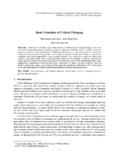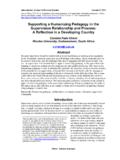Transcription of Gregory Bateson’s Theory of Mind: Practical …
1 Gregory bateson s Theory of Mind: Practical Applications to pedagogy by Lawrence S. Bale November 1992 Gregory bateson was one of the first scholars to appreciate that the patterns of organization and relational symmetry evident in all living systems are indicative of mind. We should not forget that due to the nineteenth century polemic between science and religion, any consideration of purpose and plan, , mental process, had been a priori excluded from science as non-empirical, or immeasurable. Any reference to mind as an explanatory or causal principle had been banned from biology. Even in the social and behavioral sciences, references to mind remained suspect. Building on the work of Norbert Wiener and Warren McCulloch,1 bateson realized that it is precisely mental process or mind which must be investigated.
2 Thus, he formulated the cybernetic epistemology and the criteria of mind that are pivotal elements in his ecological philosophy. In fact, he referred to cybernetics as an epistemology: , the model, itself, is a means of knowing what sort of world this is, and also the limitations that exist concerning our ability to know something (or perhaps nothing) of such matters. As his work progressed, bateson proposed that we consider Epistemology as an overarching discipline of the natural sciences, including the social and behavioral sciences: a meta-science whose parameters extend to include the science of mind in the widest sense of the word. Ideally, teaching should entail an unending search for theoretical and methodological perspectives that inspire and challenge teacher and students alike. In that spirit, this essay presents an overview of the cybernetic principles that influenced so much of bateson s work, and discusses his understanding of the concepts information and communication, which are pivotal elements of his cybernetic epistemology and his Theory of mind.
3 The essay concludes with a brief rendering of bateson s learning Theory , and since the essay reflects the highly abstract and formal tone of bateson s work, at various junctures along the way some of the Practical applications that this complex material may have for pedagogy are indicated. 2 The Cybernetic Paradigm: A Brief Introduction The term Cybernetics was coined by Norbert Wiener, at the end of World War Two, in reference to the, entire field of control and communication Theory , whether in the machine or in the animal. 2 As such, cybernetics has become a master concept which assimilated a number of analytic methods, including computerization and simulation, set Theory , graph Theory , net Theory , automata Theory , decision Theory , queueing Theory , game Theory , and general systems Theory . As is apparent in the wealth of available literature, cybernetic processes became discernible to many theorists, not only in biological systems, but also in the sub-organic and supra-organic world from microphysics to organic life, through social groups, to the biosphere of our planet, and beyond.
4 The introduction of cybernetic principles led to the identification of systemic invariance or isomorphisms throughout the observable cosmos. Here we should note that whether or not employ-ment of the cybernetic paradigm has been appropriate in each instance remains an area of dispute. Nevertheless, once perceived, the recognition of such patterns has fostered a valuable epistemic shift: from consideration of discrete entities, to the discernment of whole systems. The recognition of systemic patterns also initiated further disclosure of the logic evident in the behavior and interaction of systems, enabling theorists to frame the formal characteristics inherent in whole ( , cybernetic) systems. The properties of such a system are identified as fourfold: 1. The system is a holistic and cannot be reduced to its parts without altering its pattern. Artificially composed aggregates, wherein the constituent elements can be added or subtracted without altering the overall system are not included.
5 2. The system is self-regulating, stabilizing itself through negative feedback loops. Thus, cybernetic systems respond to information. They scan their behavior to determine its outcome, and if this input or feedback communicates a match with the system s coded requirements, the system maintains its output, its behavior, in order to maintain the match ( , it maintains a steady-state). If the system learns that its coded requirements are not being matched, it modifies its behavior on the basis of such information. 3. The system is self-organizing. If a mismatch between sensory input and internal code persists, the system searches for, and encodes a new pattern with which to operate. Thus, in the passage of time, differentiation and complexification of the overall system may emerge through positive feedback. 4. Moreover, the system is understood as a differentiated sub-whole within a systemic hierarchy.
6 The environment in which a system exists is also a whole system, a meta-system. Whether 3ecosystem, animal, organ or cell, systems consist of subsystems that operate within a hierarchy of progressively inclusive meta-systems. As a subsystem, the system s characteristics and operations are co-determinative components of the larger system within which it is an integral component. Thus, a system may be understood as Janus-faced. As a whole, it faces inward, , the system is concerned with maintaining its internal steady state; as a sub-whole, the system faces outward, responding to its environment (a meta-system) in a potentially infinite regression of relevant contexts. Spurred by the enthusiasm with which cybernetics was received, systems research has been applied to many fields of scientific enquiry. Such research supports the evolutionary view that over time, through self-organization and mutual adaptation, systems tend to form structural hierarchies, , they fashion progressively larger, more inclusive systems out of preexisting sub-systems.
7 Furthermore, in the patterns they exhibit, these new systems generate unique qualities, including more complex organization and inherently novel forms of operation. The view which has subsequently emerged discerns a complementary relationship between the morphic nature of systemic integration and systemic differentiation within a hierarchical universe. Systemic differentiation and integration are conventionally understood as delimited by the channeling of energy, matter and information to maintain and generate Also, through the cybernetic interaction of their patterns of operation, systems tend to complexify and form hierarchies. Hence, in the realm of astronomy, hierarchical restraints are understood as gravitational; in the hierarchy from microphysics to organic life, cybernetic restraints are understood as electrochemical forces; and in social and cognitive hierarchies, such constraints are understood as operating in the communication of Notably, such research has also revealed that this phenomenon is delimited by hierarchical restraints of a morphic That is, in each of these realms the hierarchical constraints are related to pattern formation, not substance or quantity.
8 Each step between the hierarchies advances the development of form toward increasingly complex organization. Also, systems proponents point out that in asserting the irreducibility of levels, the hierarchical view of cybernetic/systems Theory conflicts with traditional monism, as well as with dualism and That is, since hierarchical constraints produce both novelty and organization, causal or generative relations necessarily exist between the levels. Hence, the cybernetic/systems view of observed reality is hierarchical: the universe is understood as a hierarchy of systems, wherein each higher level of system is composed of systems of 4lower levels. In this view, each level of the hierarchy cybernetically builds on more basic levels of organization: integrating pre-existing subsystems and micro-hierarchies into novel patterns; and fashioning new, more inclusive systems. Therefore, as observed in embryology, evolution and child development, growth and learning occur incrementally or step-wise.
9 Whole systems never begin from scratch. Their growth is inevitably based upon the organization of pre-organized components. They are both delimited and enabled by hierarchical constraints that permit stability, economy, and speed in the unfolding of new forms of life and more inclusive hierarchical levels. Since their introduction, investigation of the holistic, self-stabilizing, self-organizing and hierarchical traits formally identified in cybernetic systems has also spread into the social and behavioral sciences. Thus, the informational nature of cybernetic processes: including the concepts of feedback, mutual causality, and self-regulating systems , that cybernetic systems adapt to and alter their environments through sequences of self-stabilization around steady states have been adopted and fruitfully employed in these disciplines. Arguably, the most significant contribution of cybernetics to these disciplines stems from an appreciation of the informational character of the processes evident in cybernetic systems.
10 Along with other vital insights, this view supports a collapse of the supposed dichotomies between subjective and objective data. Consequently, through the employment of the cybernetic paradigm, phenomena previously dismissed as non-empirical including feeling, emotions, cognition and perception of meaning were judged accessible and relevant to scientific inquiry. In summary, we may note that the principles underlying the cybernetic paradigm have been recognized as a valuable means of conceptualizing humankind, not only as a biological entity, but also as a social and cognitive Some scholars have objected to the dehumanizing effect of applying principles derived from machines to the study of human beings. Yet, the aim of employing cybernetic theories in the social and behavioral sciences has never been to reduce identity formation subjective learning processes, unconscious symbolic processes, etc.





